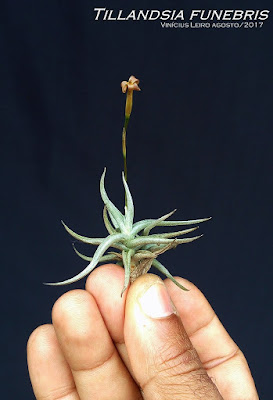Tillandsia funebris is native to Bolivia, Paraguay and northern Argentina. It is found in dry forest at altitudes ranging from 450 to just over 800 meters above sea level.
Tillandsia funebris is a species of the genus Tillandsia. This species was described by Alberto Castellanos in 1933.
IDENTIFY TILLANDSIA FUNEBRIS AIR PLANT
Tillandsia funebris is native to Bolivia, Paraguay and northern Argentina. It is found in dry forest at altitudes ranging from 450 to just over 800 meters above sea level.
It is a small sized epiphyte (10 cm with inflorescence), caulescent species that can branch out and form fairly dense clumps with few, tortuous, polystic (sometimes distich), spread, very scaly leaves. The sheaths are distinct, very nested, glabrous, veined, with membranous margins. The limbs are more or less twisted, triangular, 4 to 5 cm long, keeled and covered with scales.
This air plant bloom from the simple, glabrous inflorescence with a single, loose spike with few flowers. The peduncle is 4 to 6 cm long, glabrous, tortuous, erect and terminal. The bracts of the flowering stem are often absent, or there are only one or two, pointed and veined, on the upper part of the peduncle. The closest to the top of the inflorescence is often glabrous, while the one below is slightly scaly. The floral bracts are smooth, longer than the sepals, brownish and almost oval. The flowers are almost sessile, erect, non-tubular, few, 1 cm long. The petals are bent down, brownish (sometimes tinged with yellow), becoming darker when dry. The stamens and pistil are included.
TILLANDSIA FUNEBRIS AIR PLANT CARE AND CULTURE
Cultural information should only be used as a guide, and should be to be adapted to suit you. Your physical location; where you grow your plants, how much time you have to devote to their care, and many other factors, will need to be taken into account. Only then can you decide on the cultural methods that best suit you and your plants.
Light:
Tillandsia funebris requires a good light, avoiding if possible the full sun in the summer afternoon (especially if the plant is young or has not been used). Place the plant very close to a window indoors in the winter and preferably outside the summer in a sunny situation.
Temperature:
The required temperature ranging from 10 to 32°C. Get it early enough in the fall if you grow it outside, so that it does not face night temperatures below 6 ° C, especially if it is wet. The plants can faced temperatures close to 0 ° C (sheltered and dry) for a few hours without damage.
Humidity:
This air plant need the weak level of humidity. Good aeration is required, the plant must dry quickly (in less than an hour).
Substrate, growing media and repotting:
Tillandsia funebris refer to be mounted on a solid substrate that does not retain water. You can glue the plant directly to the surface with a strong adhesive, or you can wire the plant to the base. Don't cover the base of the plant with moss or it may rot. It can be grown on almost any imaginable decorative mount, including shells, rocks, slate, driftwood, etc.
Watering:
Two or three times a week in summer, once or twice week in winter according to the luminosity and the ambient humidity. Obviously when it rains and if you grow it outside, it counts as a watering.
Fertilizer:
This air plant can be fertilized with the moderate doses. Once a month in the summer and maximum 1 time every two months in the winter.















COMMENTS